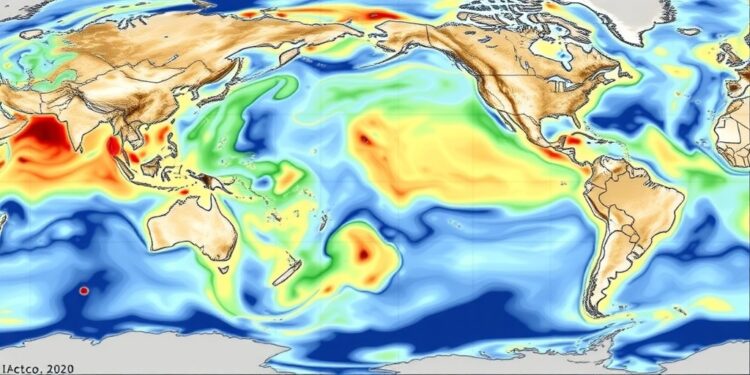As the effects of climate change become increasingly evident, recent research has illuminated a significant phenomenon occurring in the Southern Ocean, located between Antarctica and global landmasses. This body of water, known for its deep cold currents, plays a critical role in regulating global temperatures by absorbing and storing heat from the atmosphere. A new study led by researchers from Cornell University reveals that as warming continues in the Southern Ocean, its eventual release of this heat will have far-reaching consequences, particularly in terms of precipitation patterns across East Asia and the Western United States.
The repercussions of Southern Ocean warming are not fully contained to its immediate surroundings; rather, they echo across the globe. The concept of "teleconnections" describes how changes in one part of the world can influence climate conditions in distant regions. The researchers highlighted that this heat release is projected to lead to notable increases in precipitation in East Asia during the summer months and in the Western U.S. during the winter. This chain reaction resembles the mechanisms of the El Niño phenomenon, whereby alterations in sea surface temperatures in one region can lead to distinct weather patterns elsewhere.
The findings have emerged from a sophisticated computer modeling study that strives to reduce the uncertainties previously associated with climate predictions. In discussions surrounding climate change, uncertainties often pose a significant barrier to effective policy and mitigation strategies. Hanjun Kim, a postdoctoral associate and co-author of the study, underscores the importance of identifying the underlying causes of these uncertainties. The research revealed that low-altitude cloud feedbacks over the Southern Hemisphere are instrumental in affecting sea-surface temperatures, contributing to discrepancies observed in different climate models.
The Southern Ocean’s unparalleled capacity for heat absorption arises from its distinct oceanographic properties. Specifically, the strong upwelling of deep cold water allows the Southern Ocean to take in more heat than other oceanic bodies can. However, this process is not infinite. Over time, as the Southern Ocean continues to warm, the stored heat will gradually be released back into the atmosphere, setting off a cascade of climatic changes worldwide. The study indicates that this new precipitation pattern could persist for as long as 150 years, independent of greenhouse gas mitigation efforts. This projection places a spotlight on the pressing need for global action against climate change, given that the consequences may unfold regardless of immediate attempts at reducing emissions.
Prior models had hinted at such precipitation increases linked to Southern Ocean warming, although they often differed widely in their projections. The current research serves as a bridge, refining earlier predictions and offering a more cohesive understanding of climate interactions. The low-lying clouds over the Southern Ocean restrict heat return to the atmosphere, thereby acting as a vital regulator of sea surface temperatures. By incorporating insights into cloud feedbacks, this study moves toward more reliable forecasting of global temperatures and regional climates.
As the researchers highlight, observational data on cloud feedbacks in the Southern Ocean remain limited. With insufficient monitoring facilities in Antarctica to gather comprehensive data, the call for more robust observational networks becomes imperative. Enhanced monitoring efforts in these remote regions would not only bolster current models but could lead to breakthroughs in climate science, offering clearer insights into the nuances of environmental changes across the Southern Hemisphere and beyond.
In light of these revelations, the implications for policymakers and climate scientists are profound. As precipitation patterns adjust and new climatic realities emerge, the potential for increased flooding and altered water resources cannot be overstated. This could have dire consequences for agriculture, urban infrastructure, and ecosystems. In the United States, for example, increased winter precipitation may lead to higher flood risks in already vulnerable regions. Meanwhile, East Asia may experience changes that impact agricultural practices and water resource distribution, necessitating adaptive strategies to mitigate potential harms.
Importantly, the long-lasting nature of these climate changes stresses the urgency of proactive measures. Stakeholders must acknowledge that the effects of Southern Ocean warming are not merely a distant threat but a near-term reality that requires immediate attention. The simulations predict that the transition from occasional occurrences of these climatic phenomena to a more permanent shift in weather patterns is imminent, making the need for informed, timely action all the more crucial.
This study not only enriches scientific discourse around climate change but also serves as a clarion call for increased investment in climate research and monitoring. As global temperatures rise, the need to strengthen our understanding of complex ocean-atmosphere interactions becomes pressing. By bridging gaps in knowledge and refining predictive models, researchers can equip decision-makers with tools necessary to confront the challenges posed by climate change.
In conclusion, the research underscores a pivotal shift in our understanding of the Southern Ocean’s role in global climate dynamics. The implications of a warming Southern Ocean and its subsequent impact on precipitation patterns present substantial challenges requiring collaborative efforts. With the support of an integrated scientific community, advancements in observational capabilities, and informed policy measures, society may navigate the complexities of our shifting climate landscape more effectively. As we stand on the precipice of profound changes, the need for vigilant action and adaptation has never been clearer.
Subject of Research: Southern Ocean warming and its effects on global precipitation patterns.
Article Title: Higher precipitation in East Asia and western United States expected with future Southern Ocean warming.
News Publication Date: 2-Apr-2025.
Web References: Nature Geoscience article
References: Cornell Chronicle story
Image Credits: Not applicable.
Keywords
Climate modeling, Precipitation, Clouds, Global temperature, Computer modeling, Atmosphere, Asia, Ocean warming.




